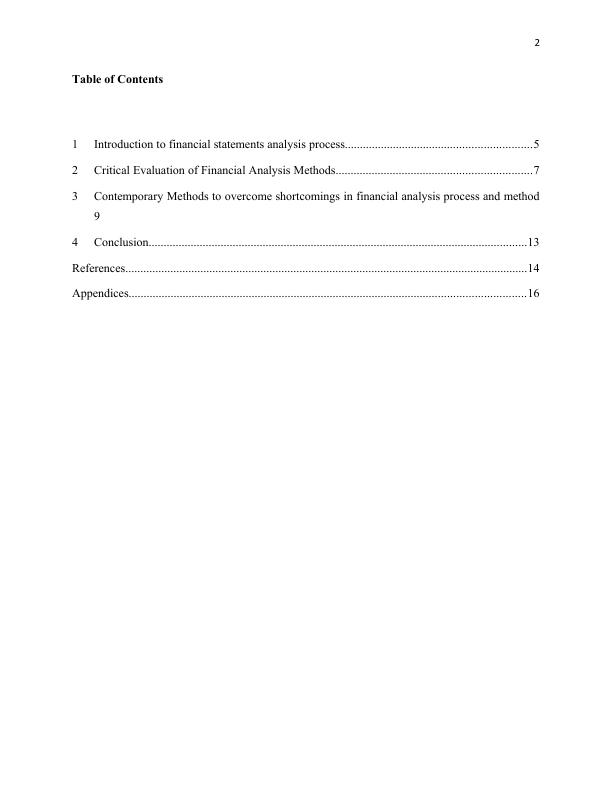Financial Statements Analysis Process
Added on 2022-03-29
25 Pages4694 Words27 Views
“Principal Methods of analysing company Accounts”
Words: 3000
Words: 3000

2
Table of Contents
1 Introduction to financial statements analysis process..............................................................5
2 Critical Evaluation of Financial Analysis Methods.................................................................7
3 Contemporary Methods to overcome shortcomings in financial analysis process and method
9
4 Conclusion..............................................................................................................................13
References......................................................................................................................................14
Appendices....................................................................................................................................16
Table of Contents
1 Introduction to financial statements analysis process..............................................................5
2 Critical Evaluation of Financial Analysis Methods.................................................................7
3 Contemporary Methods to overcome shortcomings in financial analysis process and method
9
4 Conclusion..............................................................................................................................13
References......................................................................................................................................14
Appendices....................................................................................................................................16


4
List of Figures
Figure 1: Liquidity ratios of Booker Group Plc.............................................................................16
Figure 2: Liquidity ratios of Tate & Lyle......................................................................................17
Figure 3: Leverage ratios of Booker Group Plc.............................................................................17
Figure 4: Leverage Ratios of Tate & Lyle.....................................................................................18
Figure 5: Activity Ratios of Booker Group Plc.............................................................................18
Figure 6: Activity ratios of Tate & Lyle........................................................................................19
Figure 7: Profitability ratios of Booker Group Plc........................................................................20
Figure 8: Profitability Ratios of Tate & Lyle................................................................................21
Figure 9: Market Ratio...................................................................................................................22
Figure 10: Horizontal Analysis......................................................................................................22
Figure 11: DuPont Analysis...........................................................................................................25
List of Figures
Figure 1: Liquidity ratios of Booker Group Plc.............................................................................16
Figure 2: Liquidity ratios of Tate & Lyle......................................................................................17
Figure 3: Leverage ratios of Booker Group Plc.............................................................................17
Figure 4: Leverage Ratios of Tate & Lyle.....................................................................................18
Figure 5: Activity Ratios of Booker Group Plc.............................................................................18
Figure 6: Activity ratios of Tate & Lyle........................................................................................19
Figure 7: Profitability ratios of Booker Group Plc........................................................................20
Figure 8: Profitability Ratios of Tate & Lyle................................................................................21
Figure 9: Market Ratio...................................................................................................................22
Figure 10: Horizontal Analysis......................................................................................................22
Figure 11: DuPont Analysis...........................................................................................................25

5
1 Introduction to financial statements analysis process
The analysis of financial statements of a company is done to evaluate the performance of a
company from different perspectives. There are number of methods which are presented by
different researcher to do the analysis of the company’s accounts. However, there are four
principal methods which are horizontal analysis, vertical analysis, ratio analysis and Du Pont
analysis, used to analyse the financial statements (Deegan, 2013).
Horizontal Analysis of Financial Statements
Horizontal analysis is done by comparing the values of the financial statements which a company
has incurred over a period of time. It shows the results in a percentage value which makes it
easier to identify the growth or decline in the different sectors of a company. If any area shows
an abnormal amount of change, it can be highlighted easily so that the further investigation can
be done in that particular area to observe the reasons behind change. Therefore, it can be said
that it will be helpful in the detection of fraud also. It is performed by defining a base year and
than all the future values will be regarded as the percentage of the base year which is assumed to
be 100%. (Healy and Palepu, 2012).
It will also help a company to have complete information about the procedures which have been
followed in the company to perform different functions. Horizontal analysis broadens the view of
the users about a company’s insight as it evaluates all the financial statements at a same time for
the same period. It is a possibility that the outcomes are quite different for both the statements.
(Brochet, Jagolinzer and Riedl, 2013). The horizontal analysis can be done by using the normal
values which does not involve any percentages and can be regarded as absolute comparison. On
the other hand, percentage analysis can also be done which is preferred by many users as it
provides better understanding. (DeFusco, McLeavey, Pinto, Anson and Runkle, 2015)
Vertical Analysis of Financial Statement
Vertical analysis is also regarded as a principal method which is used to analyse the performance
of a company’s accounts. In this method, all the items will be valued in the form of percentages
1 Introduction to financial statements analysis process
The analysis of financial statements of a company is done to evaluate the performance of a
company from different perspectives. There are number of methods which are presented by
different researcher to do the analysis of the company’s accounts. However, there are four
principal methods which are horizontal analysis, vertical analysis, ratio analysis and Du Pont
analysis, used to analyse the financial statements (Deegan, 2013).
Horizontal Analysis of Financial Statements
Horizontal analysis is done by comparing the values of the financial statements which a company
has incurred over a period of time. It shows the results in a percentage value which makes it
easier to identify the growth or decline in the different sectors of a company. If any area shows
an abnormal amount of change, it can be highlighted easily so that the further investigation can
be done in that particular area to observe the reasons behind change. Therefore, it can be said
that it will be helpful in the detection of fraud also. It is performed by defining a base year and
than all the future values will be regarded as the percentage of the base year which is assumed to
be 100%. (Healy and Palepu, 2012).
It will also help a company to have complete information about the procedures which have been
followed in the company to perform different functions. Horizontal analysis broadens the view of
the users about a company’s insight as it evaluates all the financial statements at a same time for
the same period. It is a possibility that the outcomes are quite different for both the statements.
(Brochet, Jagolinzer and Riedl, 2013). The horizontal analysis can be done by using the normal
values which does not involve any percentages and can be regarded as absolute comparison. On
the other hand, percentage analysis can also be done which is preferred by many users as it
provides better understanding. (DeFusco, McLeavey, Pinto, Anson and Runkle, 2015)
Vertical Analysis of Financial Statement
Vertical analysis is also regarded as a principal method which is used to analyse the performance
of a company’s accounts. In this method, all the items will be valued in the form of percentages

6
in comparison with their totals. It means that if a vertical analysis has performed for the income
statement than all the items will be calculated as the percentage value of sales as sales is the
dominant item in the income statement. Similarly, if the vertical analysis is done for the balance
sheet, assets, liabilities and equities will be identified as the percentage of their respective
sections total amounts. The total amounts are assumed to be 100% in vertical analysis.
(Horngren, Sundem, Schatzberg and Burgstahler, 2013).
It is helpful to analyse that if a certain item is showing similar share in the total amount as the
last year or not. For example if it is identified that the operating expenses are 15% in the year
2015 and they are observed to be 20% in 2016, the reasons can be find out behind this increase in
order to increase the profitability. The horizontal analysis involves two years for the comparison;
however, vertical analysis can be done for a single year. The final percentages will then be
analysed on the timeline that either the share of a single item is increasing or decreasing in the
total values (Healy and Palepu, 2012).
Ratio Analysis of Financial Statement
Ratio analysis is the most common method which is used to analyse the performance of a
company’s accounts. It is preferred by the stakeholders as it analyses the values of financial
statements from different perspectives. Liquidity, solvency, profitability, efficiency and investing
are some frequently used ratios which are calculated to analyse the performance of financial
statements (Rothaermel, 2015). The ratio analysis also identifies the performance of a company
in comparison with the industry so that it can be identified that how well a company is
performing compared to its competitors. It will create opportunity for an investor as he can invest
in the most well performed company which is present in the industry (Pratt, 2013).
If the ratios of a company are unfavourable, the reasons can be identified behind the low
performing areas. It is helpful in making strategic decisions also by highlighting the low
performing areas so that the importance can be given to them in order to improve it. (Robinson,
Henry, Pirie and Broihahn, 2015). It also identifies the profitability of a company and the impact
of its decisions in different area, mainly in the dividends so that the investors can be attracted foe
the investment in a company (Warren, Reeve and Duchac, 2013).
in comparison with their totals. It means that if a vertical analysis has performed for the income
statement than all the items will be calculated as the percentage value of sales as sales is the
dominant item in the income statement. Similarly, if the vertical analysis is done for the balance
sheet, assets, liabilities and equities will be identified as the percentage of their respective
sections total amounts. The total amounts are assumed to be 100% in vertical analysis.
(Horngren, Sundem, Schatzberg and Burgstahler, 2013).
It is helpful to analyse that if a certain item is showing similar share in the total amount as the
last year or not. For example if it is identified that the operating expenses are 15% in the year
2015 and they are observed to be 20% in 2016, the reasons can be find out behind this increase in
order to increase the profitability. The horizontal analysis involves two years for the comparison;
however, vertical analysis can be done for a single year. The final percentages will then be
analysed on the timeline that either the share of a single item is increasing or decreasing in the
total values (Healy and Palepu, 2012).
Ratio Analysis of Financial Statement
Ratio analysis is the most common method which is used to analyse the performance of a
company’s accounts. It is preferred by the stakeholders as it analyses the values of financial
statements from different perspectives. Liquidity, solvency, profitability, efficiency and investing
are some frequently used ratios which are calculated to analyse the performance of financial
statements (Rothaermel, 2015). The ratio analysis also identifies the performance of a company
in comparison with the industry so that it can be identified that how well a company is
performing compared to its competitors. It will create opportunity for an investor as he can invest
in the most well performed company which is present in the industry (Pratt, 2013).
If the ratios of a company are unfavourable, the reasons can be identified behind the low
performing areas. It is helpful in making strategic decisions also by highlighting the low
performing areas so that the importance can be given to them in order to improve it. (Robinson,
Henry, Pirie and Broihahn, 2015). It also identifies the profitability of a company and the impact
of its decisions in different area, mainly in the dividends so that the investors can be attracted foe
the investment in a company (Warren, Reeve and Duchac, 2013).

End of preview
Want to access all the pages? Upload your documents or become a member.
Related Documents
(DOC) Complete Strategic Finance Assignmentlg...
|46
|10766
|192
Strategic Financial Analysislg...
|55
|8602
|68
Strategic Financial Analysis TABLE OF CONTENTSlg...
|57
|13738
|400
Strategic Financial Analysis - Methods and Contemporary Approacheslg...
|69
|13055
|110
Strategic Financial Analysis - Assignmentlg...
|32
|4920
|422
Strategic Financial Analysis Assignmentlg...
|25
|7898
|88
